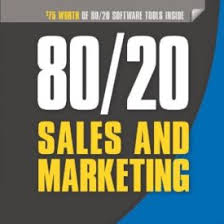
80/20 Sales and Marketing by Perry Marshall contains enough perspective-altering analysis to easily justify spending a year to digest it all. Perry Marshall, an engineer by trade, switched careers to sales and eventually to become an expert internet marketer. He wrote the definitive book on Google Adwords and explained internet marketing in the early internet days. His book on 80/20 is a splinter off of Richard Koch’s The 80/20 Principle which is itself an adaptation of the Pareto principle.
The Pareto Principle
The Pareto principle, observed most famously by Italian economist Vilfredo Pareto in 1896, states that 80% of the effects are results of 20% of the causes. Perry Marshall dedicates his book to applying this principle to sales and marketing with the aim of identifying the 20% of the effectiveness.
Throughout the book, Perry Marshall applies the 80/20 lens to various activities regarding sales and marketing. He identifies three areas to apply the principle:
- Divide your clients to find the 20% driving your company,
- Divide your time to identify the 20% of your activities creating the value, and
- Despite the inherent nature of the 80/20, we can employ charity to undo the ruthless nature of the principle.
20% Of Your Clients Drive 80% Of Your Business
The first point he makes about managing a business is to identify the 20% of your clients who will propel your business and not invest much time in the 80% of your other sales. He calls this “racking the shotgun;” identifying the clients most likely to value, and purchase, your product.
To make things even more interesting, he claims the distribution within the 20% contains its own 80/20 breakdown. So, 20% of the 20% are providing 80% of the sales within that subset. This trend continues for as much data as you can analyze. Like a Russian doll; opening one subset of data leads to see another subset with a similar distribution.
The primary role of effective management is identifying and targeting the 20% of these clients. These “little hinges that swing big doors” are where an entrepreneur needs to invest time so that they can drill down and detect the subtle activities making the most impact to their business. Spending time with your 20% clients is likely to be the best investment leading to more products to serve those same clients.
Make $1,000 Per Hour
The second main point analyzes the time relating to 80/20. If the Pareto distribution is correct, then our days are distributed in a like manner and the profitability time is also subject to the same principle: 20% time earns 80% of the value.
The wheels come off here when he compares earnings to activity. He suggests that someone earning only $20 per hour has minutes during his day where he is worth $1,000 for a minute based on the distribution. Moving up the income spread he argues that it is not uncommon for business owners to earn $10,000 per hour for their work!
Effective managers spend time working on their highest value activities while delegating low-value activities. Work potentially generating $10,000 per hour includes creating new and better products, repositioning your message and executing brilliant ideas, among others. Unfortunately, most managers spend their time on tasks easily delegated, not optimizing their highest value. The effective manager is someone relentlessly seeking to remain in the most valuable activities for their time.
This is the most interesting part of the book. His laser-focused attention to effectiveness in the business is of supreme importance to the business looking to grow. Effective management must constantly be looking to delegate lower value tasks and searching for the highest and best use of their time.
80/20 Cannot Be Fixed From The Outside; You Can Only Fix It From The Inside
The third main point he makes comes at the end of the book. Stating the phrase, “Half your battles were won for you before you were even born, and don’t you forget it,” Perry then applies the 80/20 principle to worldwide income distribution. The principle holds and demonstrates how incredibly wealthy we are on a global scale. Rather than focus on first world problems like our latte being too foamy, we have an opportunity to do something for those who are less fortunate.
This chapter recognizes the exclusivity of the 80/20. Spending time serving only the highest 20% income will alienate the majority of the world. Charity, he posits, is the lever to pull to upend the Pareto distribution. The act of giving reverses the concentration of wealth inherent in a Pareto distribution.
While everyone loves a success story, it is helpful to remember that most people in the 80% will remain there for their lifetime and this is depressingly Darwinian. Businesses which constantly focus on the 20% will by nature not serve the majority of the world’s population, people who may need it most. It is important to remember the distribution has winners and losers.
The Takeaway
While his background is unmistakably internet marketing, this book offers a thorough analysis of data distributions from many industries to support his theory. His stories throughout the book demonstrate the minority of clients drive profits, the minority of time produces value and the response to finding ourselves in the 20% of worldwide income is charity towards the majority.
While many practitioners believe their highest value work is the $150+ per hour work they perform for clients. In reality, their time is often best spent on their businesses in specific roles designed to maximize their abilities.
The global distribution of wealth and our response to it aligns with the Red Earth core value of gratitude. The data continue to demonstrate what a rare and privileged position the highest-earning 20% of the world’s population find themselves. The Red Earth response to this phenomenon is gratitude.
In closing, this is an excellent book to understanding effective and efficient marketing and management. This book is applicable to business owners and entrepreneurs interested in improving the effectiveness of management of their companies.
And who knows, maybe the time spent reading this book will be $10,000 per hour work.
